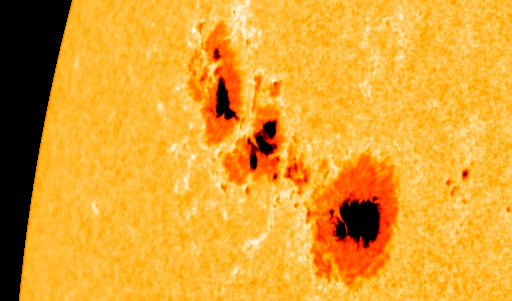Behemoth sunspot 1302 unleashed another strong flare on Saturday morning, an X1.9-category blast at 5:40 am EDT. NASA's Solar Dynamics Observatory (SDO) recorded the extreme ultraviolet flash.
The movie below shows a shadowy shock wave racing away from the blast site. This is a sign that the blast produced a coronal mass ejection (CME) that could deliver a glancing blow to Earth's magnetic field today.
Active Region 1302 unleashes an X1.9-category solar flare at 5:40 am EDT on Sept. 24, 2011. NASA's Solar Dynamics Observatory (SDO) recorded the extreme ultraviolet flash in composite wavelengths (211, 193, 171 angstrom). Note: The sun has been rotated 90 degrees clock-wise for better video presentation. Credit: NASA/SDO/GOES
Since the X1.9-flare, active region (AR) 1302 has unleashed M8.6 and M7.4 flares on Sept. 24 and an M8.8 flare early on Sept. 25. None of the blasts have been squarely Earth-directed, but this could change as the sunspot turns toward our planet in the days ahead. AR1302 is growing and shows no immediate signs of quieting down.
What is a solar flare?
A solar flare is a burst of radiation coming from the release of magnetic energy associated with sunspots. Flares are the largest explosive events in our solar system and are seen as bright areas on the sun that can last from minutes to hours. We typically see a solar flare by the light it releases, at most every wavelength of the spectrum. The primary ways we monitor flares are in x-rays and optical light. Flares are also sites where particles (electrons, protons, and heavier particles) are accelerated.
What is a coronal mass ejection (CME)?
The sun's outer atmosphere, the corona, is shaped by strong magnetic fields and when those fields are closed, often above sunspot groups, the confined solar atmosphere can release bubbles of gas and magnetic fields called coronal mass ejections. A large CME can contain a billion tons of matter that can be accelerated to several million miles per hour. Solar material streams out through the interplanetary medium, impacting any planet or spacecraft in its path. CMEs are sometimes associated with flares but can occur independently.

Sunspot 1302 has already produced two X-flares (X1.4 on Sept. 22nd and X1.9 on Sept. 24th). Each of the dark cores in this image from SDO is larger than Earth, and the entire active region stretches more than 100,000 km from end to end. The sunspot's magnetic field is currently crackling with sub-X-class flares that could grow into larger eruptions as the sunspot continues to turn toward Earth. Credit: NASA/SDO/HMI






Comments